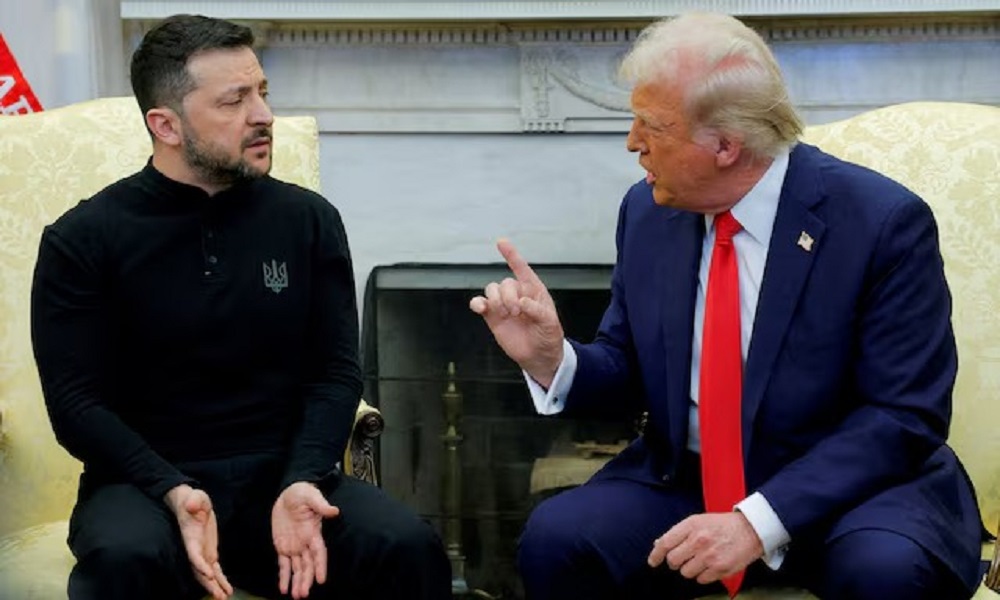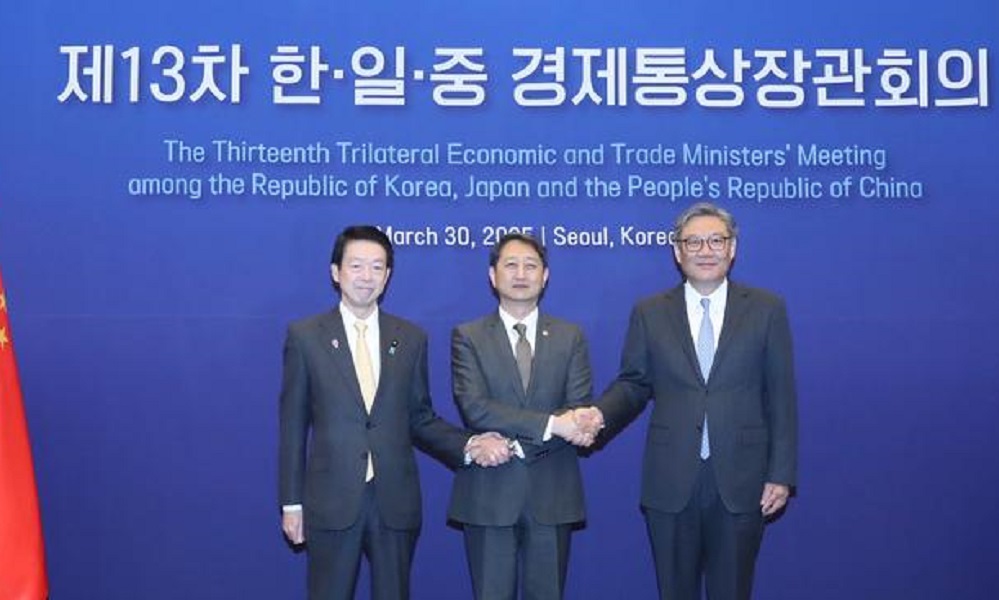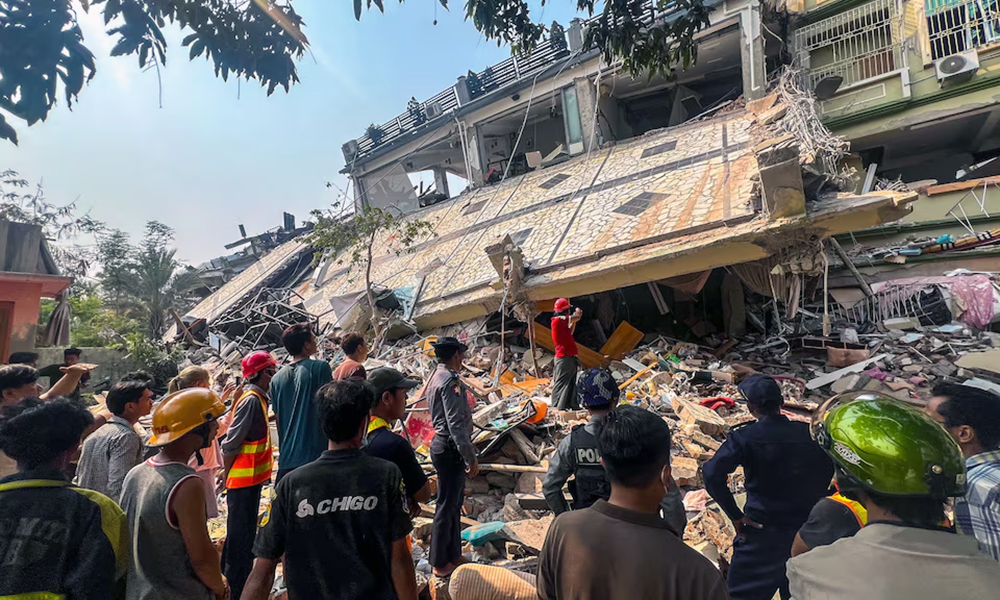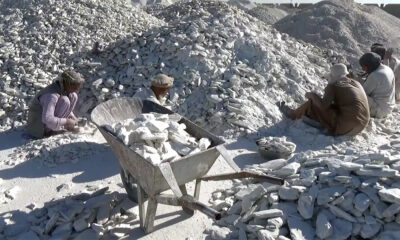World
Kuwait’s Emir Sheikh Nawaf dies, Sheikh Meshal named as successor

Kuwait’s Emir Sheikh Nawaf al-Ahmad al-Sabah died on Saturday, aged 86, according to the royal court, just over three years after assuming power in the U.S.-allied Gulf oil producer, Reuters reported.
The cause of his death was not immediately disclosed. The emir was admitted to hospital late last month due to what the state news agency described at the time as an emergency health problem but said that he was in a stable condition.
Crown Prince Sheikh Meshal al-Ahmad al-Sabah, 83, who has been Kuwait’s de facto ruler since 2021, when the frail emir handed over most of his duties, was named as Sheikh Nawaf’s successor.
Kuwait announced 40 days of mourning and a three day closure of official departments. World leaders paid tribute to Sheikh Nawaf and offered their condolences to his successor, Sheikh Meshal, the Al Sabah family and the people of Kuwait.
The Islamic Emirate of Afghanistan (IEA) also issued a message of condolence on the death of Sheikh Nawaf.
In a short statement, the IEA said: “It is with great sadness that we received the news that the Emir of Kuwait, Sheikh Nawaf Al-Ahmad Al-Jaber Al-Sabah, passed away.
“The Islamic Emirate of Afghanistan and the entire Afghan nation share this great grief with the people of Kuwait,” the statement read.
British Prime Minister Rishi Sunak said in a statement on social media platform X that he was saddened to hear of the passing of Sheikh Nawaf, who he described as a great friend of the United Kingdom that would be remembered fondly.
Emirati President Sheikh Mohamed bin Zayed wrote on X that Sheikh Nawaf had been a wise leader who played a major role in strengthening Kuwait-UAE relations.
Sheikh Nawaf became emir in September 2020 following the death of his brother, Sheikh Sabah, who had ruled for more than a decade and shaped the state’s foreign policy for over 50 years.
Sheikh Nawaf was seen by diplomats as a consensus builder even though his reign was marked by an intense standoff between the government and elected parliament, which had hindered key structural reforms in the oil rich Gulf state. In recent months, consensus returned between the government and the parliament.
Kuwait, holder of the world’s seventh-largest oil reserves, borders Saudi Arabia and Iraq, and lies across the Gulf from Iran. It was invaded and occupied by Iraq in 1990, sparking the first Gulf war several months later in 1991 when the United States and other nations defeated Iraq and liberated Kuwait.
Since he took over in 2020, Sheikh Nawaf maintained a foreign policy that balanced ties with those neighbours, whilst domestically eight governments were formed under his rule.
Under Kuwait’s constitution, the crown prince automatically becomes emir but assumes power only after taking an oath in parliament. The new emir has up to a year to name an heir.
Analysts and diplomats say that Sheikh Nawaf, and his crown prince Sheikh Meshal, both appeared to align Kuwait more closely with regional powerhouse Saudi Arabia.
The new emir’s choice of crown prince and premier – who would be tasked with managing the government’s often stormy relationship with parliament – will be watched closely as a younger generation of Kuwait’s ruling family jostles for position, Reuters reported.
Such factional struggles within the Al Sabah family have often played out in parliament as contenders for succession build their own political capital and domestic base.
Before handing over most of his constitutional duties to his designated heir, Sheikh Nawaf tried to secure a detente on the domestic political scene, including by issuing an amnesty pardoning dissidents that had been long-sought by opposition figures.
But the stalemate continued, leaving Sheikh Meshal to try to put an end to the political bickering this year by dissolving parliament and holding early elections in June.
Kuwait bans parliamentary parties but is still one of the region’s most politically liberal states, with a voluble political debate and the region’s most powerful elected legislative assembly that includes Sunnis, Shi’ites, liberals and Islamists, Reuters reported.
World
Trump says Zelenskiy wants to back out of critical minerals deal

U.S. President Donald Trump said on Sunday Ukrainian President Volodymyr Zelenskiy wants to back out of a critical minerals deal, warning the Ukrainian leader would face big problems if he did.
“He’s trying to back out of the rare earth deal and if he does that he’s got some problems, big, big problems,” Trump told reporters.
“He wants to be a member of NATO, but he’s never going to be a member of NATO. He understands that.”
(Reuters)
World
South Korea, China, Japan seek regional trade amid Trump tariffs

South Korea, China and Japan held their first economic dialogue in five years on Sunday, seeking to facilitate regional trade as the three Asian export powers brace from U.S. President Donald Trump’s tariffs.
The countries’ three trade ministers agreed to “closely cooperate for a comprehensive and high-level” talks on a South Korea-Japan-China free trade agreement deal to promote “regional and global trade”, according to a statement released after the meeting.
“It is necessary to strengthen the implementation of RCEP, in which all three countries have participated, and to create a framework for expanding trade cooperation among the three countries through Korea-China-Japan FTA negotiations,” said South Korean Trade Minister Ahn Duk-geun, referring to the Regional Comprehensive Economic Partnership.
The ministers met ahead of Trump’s announcement on Wednesday of more tariffs in what he calls “liberation day”, as he upends Washington’s trading partnerships.
Seoul, Beijing and Tokyo are major U.S. major trading partners, although they have been at loggerheads among themselves over issues including territorial disputes and Japan’s release of wastewater from the wrecked Fukushima nuclear power plant.
They have not made substantial progress on a trilateral free-trade deal since starting talks in 2012.
RCEP, which went into force in 2022, is a trade framework among 15 Asia-Pacific countries aimed at lowering trade barriers.
Trump announced 25% import tariffs on cars and auto parts last week, a move that may hurt companies, especially Asian automakers, which are among the largest vehicle exporters to the U.S.
After Mexico, South Korea is the world’s largest exporter of vehicles to the United States, followed by Japan, according to data from S&P.
The ministers agreed to hold their next ministerial meeting in Japan.
(Reuters)
World
Myanmar quake death toll hits 1,700 as aid scramble intensifies
India, China and Thailand are among Myanmar’s neighbours that have sent relief materials and teams, along with aid and personnel from Malaysia, Singapore and Russia.

The toll from Myanmar’s earthquake continued to rise on Sunday, as foreign rescue teams and aid rushed into the impoverished country, where hospitals were overwhelmed and some communities scrambled to mount rescue efforts with limited resources.
The 7.7-magnitude quake, one of Myanmar’s strongest in a century, jolted the war-torn Southeast Asian nation on Friday, leaving around 1,700 people dead, 3,400 injured and over 300 missing as of Sunday, the military government said.
The junta chief, Senior General Min Aung Hlaing, warned that the number of fatalities could go up and his administration faced a challenging situation, state media reported, three days after he made a rare call for international assistance.
India, China and Thailand are among Myanmar’s neighbours that have sent relief materials and teams, along with aid and personnel from Malaysia, Singapore and Russia.
“The destruction has been extensive, and humanitarian needs are growing by the hour,” the International Federation of Red Cross and Red Crescent Societies said in a statement.
“With temperatures rising and the monsoon season approaching in just weeks, there is an urgent need to stabilise affected communities before secondary crises emerge.”
The devastation has piled more misery on Myanmar, already in chaos from a civil war that grew out of a nationwide uprising after a 2021 military coup ousted the elected government of Nobel Peace Prize laureate Aung San Suu Kyi.
Critical infrastructure – including bridges, highways, airports and railways – across the country of 55 million lie damaged, slowing humanitarian efforts while the conflict that has battered the economy, displaced over 3.5 million people and debilitated the health system rages on.
In some areas near the epicentre, residents told Reuters that government assistance was scarce, leaving people to fend for themselves.
“It is necessary to restore the transportation routes as soon as possible,” Min Aung Hlaing told officials on Saturday, according to state media. “It is necessary to fix the railways and also reopen the airports so that rescue operations would be more effective.”
The U.S. Geological Service’s predictive modelling estimated Myanmar’s death toll could top 10,000 and losses could exceed the country’s annual economic output.
Hospitals in parts of central and northwestern Myanmar, including the second-biggest city, Mandalay, and the capital Naypyitaw, were struggling to cope with an influx of injured people, the U.N. Office for the Coordination of Humanitarian Affairs said late on Saturday.
The quake also shook parts of neighbouring Thailand, bringing down an under-construction skyscraper and killing 18 people across the capital, according to Thai authorities.
At least 76 people remained trapped under the debris of the collapsed building, where rescue operations continued for a third day, using drones and sniffer dogs to hunt for survivors.
The opposition National Unity Government, which includes remnants of the previous administration, said anti-junta militias under its command would pause all offensive military actions for two weeks from Sunday.
The devastation in some areas of upper Myanmar, such as the town of Sagaing near the quake’s epicentre, was extensive, said resident Han Zin.
“What we are seeing here is widespread destruction – many buildings have collapsed into the ground,” he said by phone, adding that much of the town had been without electricity since the disaster hit and drinking water was running out.
“We have received no aid, and there are no rescue workers in sight.”
Sections of a major bridge connecting Sagaing to nearby Mandalay collapsed, satellite imagery showed, with spans of the colonial-era structure submerged in the Irrawaddy river.
“With bridges destroyed, even aid from Mandalay is struggling to get through,” Sagaing Federal Unit Hluttaw, a political association linked to the NUG, said on Facebook.
“Food and medicine are unavailable, and the rising number of casualties is overwhelming the small local hospital, which lacks the capacity to treat all the patients.”
In Mandalay, scores of people were feared trapped under collapsed buildings and most could not be reached or pulled out without heavy machinery, two humanitarian workers and two residents said.
“My teams in Mandalay are using work gloves, ropes and basic kits to dig and retrieve people,” said one of the humanitarian workers. Reuters is not naming them because of security concerns.
“There are countless trapped and still missing. The death toll is impossible to count at the moment due to the number trapped and unidentified, if alive.”
A video filmed by a Mandalay resident on Saturday and shared with Reuters showed patients in beds, some attached to drips, on the grounds outside a 500-bed orthopaedic hospital in the city.
Public and private health care facilities in Mandalay, including the Mandalay General Hospital and parts of Mandalay Medical University, were damaged by the quake, according to the World Health Organization.
Russian and Indian rescue workers were heading to Mandalay, and multiple teams of Chinese, Thai and Singapore rescue personnel have also arrived in the country.
In Bangkok, at the site of the collapsed 33-storey building, rescuers surrounded by shattered concrete piles and twisted metal continued their efforts to rescue dozens of workers trapped under the rubble.
Teerasak Thongmo, a Thai police commander, said his team of policemen and rescue dogs were racing against time to locate survivors, struggling to move around metal debris and sharp edges on an unstable structure.
“Right now, our team is trying to find anyone that might still be alive. Within the first 72 hours, we have to try and save those still alive,” he said.
Near the rescue operations, relatives and friends of the missing and trapped construction workers waited for news. Some broke down.
“Ploy, Ploy, Ploy, my daughter, I’m here for you now!” one woman wailed, as she was hugged by two others. “Ploy, can you hear me calling out for you?”
-

 Latest News5 days ago
Latest News5 days agoAfghanistan has the right to access Amu River’s water: Uzbek minister
-

 Latest News4 days ago
Latest News4 days agoAmnesty international urges Pakistan to halt Afghan deportations
-

 Latest News4 days ago
Latest News4 days agoAfghanistan-Iran-Europe railway corridor activated
-

 Business4 days ago
Business4 days agoAfghanistan ships first consignment to Europe via Khaf-Herat railway
-

 Business3 days ago
Business3 days ago36 mining contracts inked over the past year: Mines ministry
-

 Sport4 days ago
Sport4 days agoDe Kock fireworks see Kolkata thrash Rajasthan in IPL
-

 Latest News3 days ago
Latest News3 days agoDried fruit market in Herat booms ahead of Eid-al-Fitr
-

 Regional3 days ago
Regional3 days agoPowerful quake in Southeast Asia kills several, Myanmar declares state of emergency























